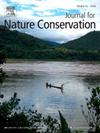The effects of organic and conventional apple orchard management systems for biodiversity: A multi-taxon study with a semi-natural benchmark
IF 2.5
3区 环境科学与生态学
Q2 BIODIVERSITY CONSERVATION
引用次数: 0
Abstract
Widespread agricultural intensification has strongly affected the biodiversity of European farmlands. Organic farming is commonly proposed as a more biodiversity-friendly alternative to mitigate this impact. However, its effectiveness for the on-field conservation of various taxa simultaneously remains unclear, especially relative to the conservation potential of a semi-natural benchmark. Given the yield penalty associated with organic farming as compared to conventional farming, it is essential to accurately assess its biodiversity benefits to evaluate whether further transitions to organic farming can be justified. Here, we aimed to quantify the effects of organic and conventional apple orchard management, as well as the influence of the surrounding landscape, on local multi-taxon biodiversity. Therefore, we quantified community composition, species abundance, and species diversity across six taxa (plants, bees, hoverflies, true bugs, grasshoppers and springtails) in organic and Integrated Pest Management (IPM) orchards, and in semi-natural grasslands as a benchmark. Organic farming showed some benefits for biodiversity compared to IPM, but responses varied significantly among taxa, with stronger positive effects on plants than on arthropods, and on species abundance rather than on species diversity. Overall, semi-natural grasslands greatly outperformed both orchard management types in terms of biodiversity, though some responses were again taxon-dependent. Furthermore, the proximity and proportion of semi-natural habitat in the landscape enhanced both local multi-taxon and several taxon-specific biodiversity metrics. We conclude that, while organic farming in apple orchards may provide some benefits for local biodiversity, its effects are inconsistent across taxa, and the presence of semi-natural habitats seems more important for biodiversity conservation in the studied apple farming landscapes.
有机和常规苹果园管理制度对生物多样性的影响:一个半自然基准的多分类群研究
广泛的农业集约化严重影响了欧洲农田的生物多样性。有机农业通常被认为是一种更有利于生物多样性的替代方案,以减轻这种影响。然而,与半自然基准的保护潜力相比,其对各种分类群同时的野外保护效果尚不清楚。考虑到有机农业与传统农业相比的产量损失,准确评估其生物多样性效益以评估进一步过渡到有机农业是否合理是至关重要的。本研究旨在量化有机和常规苹果园管理对当地多分类生物多样性的影响,以及周围景观的影响。因此,我们以有机和综合有害生物管理(IPM)果园和半自然草地为基准,对6个分类群(植物、蜜蜂、食蚜蝇、真虫、蚱蜢和弹尾)的群落组成、物种丰度和物种多样性进行了量化。与IPM相比,有机耕作对生物多样性有一定的促进作用,但不同分类群间差异显著,对植物的积极作用强于节肢动物,对物种丰富度的积极作用强于物种多样性。总体而言,半自然草地在生物多样性方面大大优于两种果园管理类型,尽管有些响应仍然是分类依赖的。此外,半自然生境在景观中的接近性和比例提高了局部多分类群和若干分类群特异性生物多样性指标。研究结果表明,虽然有机种植对苹果果园的生物多样性有一定的促进作用,但其对不同分类群的影响并不一致,半自然生境的存在似乎对苹果种植景观的生物多样性保护更为重要。
本文章由计算机程序翻译,如有差异,请以英文原文为准。
求助全文
约1分钟内获得全文
求助全文
来源期刊

Journal for Nature Conservation
环境科学-生态学
CiteScore
3.70
自引率
5.00%
发文量
151
审稿时长
7.9 weeks
期刊介绍:
The Journal for Nature Conservation addresses concepts, methods and techniques for nature conservation. This international and interdisciplinary journal encourages collaboration between scientists and practitioners, including the integration of biodiversity issues with social and economic concepts. Therefore, conceptual, technical and methodological papers, as well as reviews, research papers, and short communications are welcomed from a wide range of disciplines, including theoretical ecology, landscape ecology, restoration ecology, ecological modelling, and others, provided that there is a clear connection and immediate relevance to nature conservation.
Manuscripts without any immediate conservation context, such as inventories, distribution modelling, genetic studies, animal behaviour, plant physiology, will not be considered for this journal; though such data may be useful for conservationists and managers in the future, this is outside of the current scope of the journal.
 求助内容:
求助内容: 应助结果提醒方式:
应助结果提醒方式:


